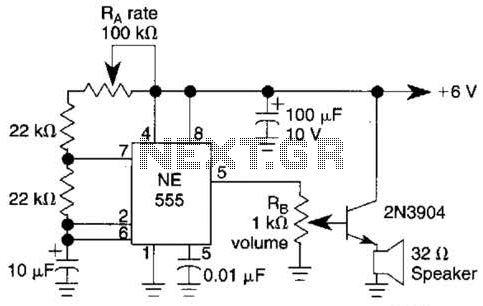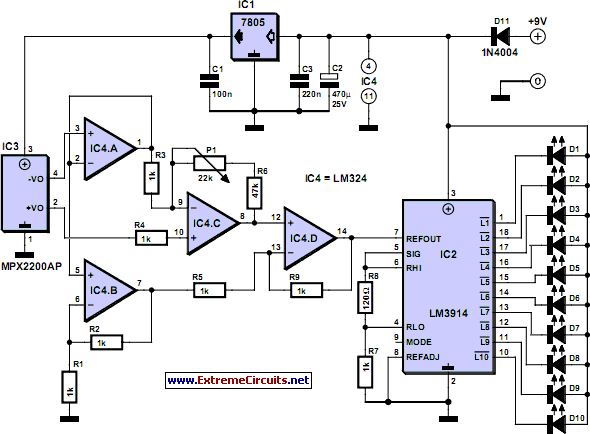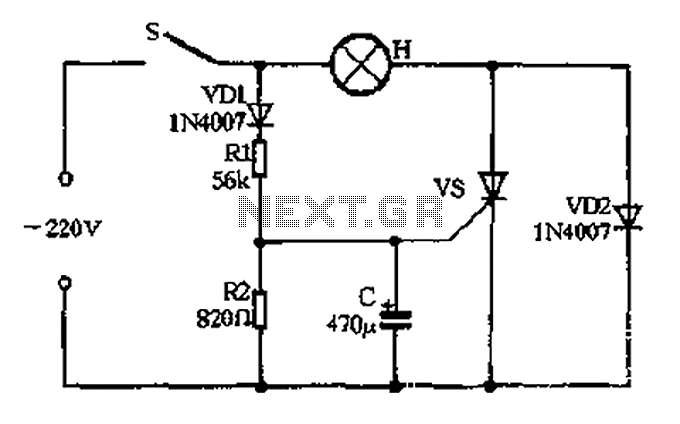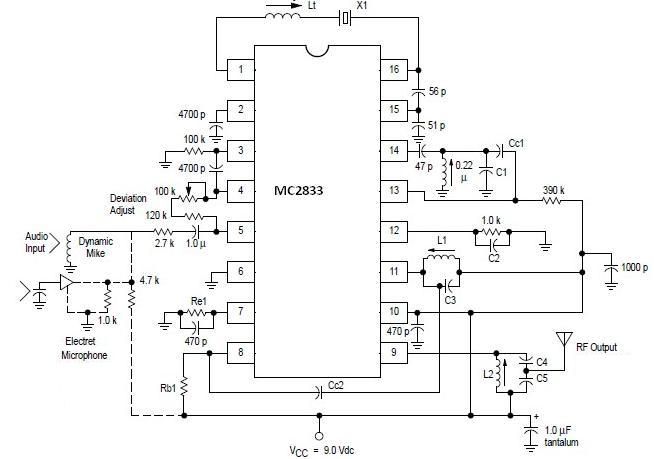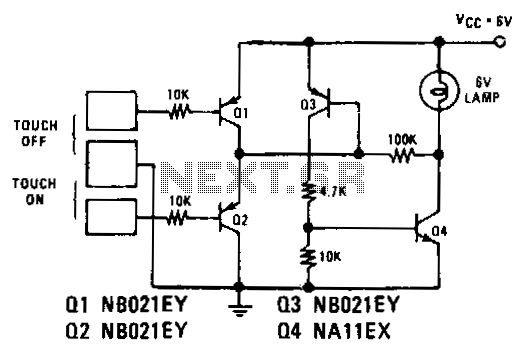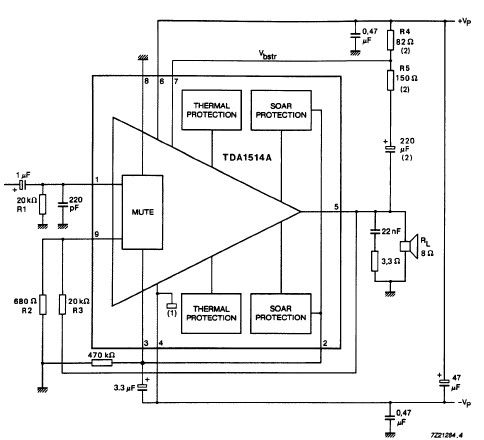
Electronic Door Release
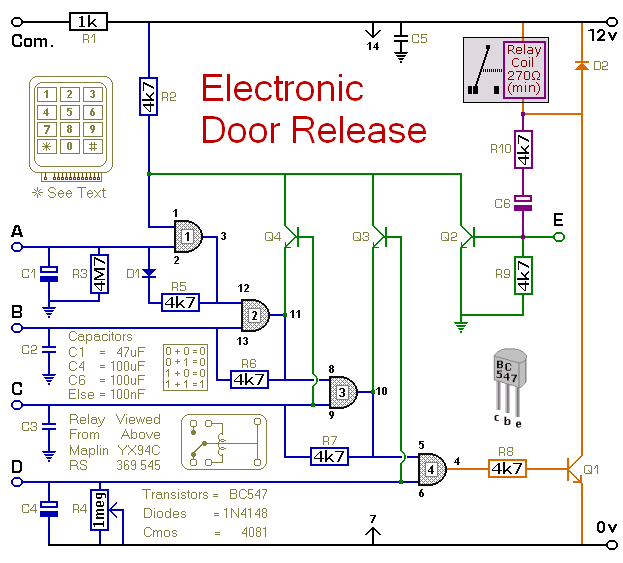
This circuit is designed to operate an electrical door-release mechanism, although it can be adapted for various applications. Users can enter a four-digit code of their choice, which will activate a relay for a duration determined by capacitor C4 and resistor R4. The relay contacts are utilized to power the release mechanism. The standby current is nearly negligible, making battery operation feasible. The circuit is designed for a 12-volt supply but is compatible with voltages ranging from 5 to 15 volts. It is essential to select a relay that matches the desired supply voltage. A multi-pole relay can be used instead of the SPCO/SPDT relay if required by the application. Caution is advised against using the onboard relay for switching mains voltage due to insufficient isolation between the relay contacts and low-voltage components. For mains voltage applications, a suitably rated relay should be mounted away from the board. Users can select four keys to use as their code and connect them to terminals labeled A, B, C, and D, with the common terminal connected to R1 and all other keys wired to terminal E. When the correct sequence of four keys is pressed, the relay will energize. With the specified values of C4 and R4, and with R4 set to its maximum, the relay will de-energize approximately one minute after releasing key D. Alternatively, substituting C4 with a 100nF capacitor and R4 with a 4.7kΩ fixed resistor will result in the relay de-energizing immediately upon releasing key D. Any keys not connected to A, B, C, or D are linked to the base of transistor Q2. If any of these incorrect keys are pressed, Q2 will pull pin 1 low, leading to a failed code entry. Similarly, pressing keys C or D out of sequence will cause Q4 or Q3 to pull pin 1 low, resulting in a failed code entry. In case of an entry mistake, the process can be restarted. The keypad must feature a common terminal with separate connections for each key; a 12-key pad typically has 13 terminals, while matrix types with 7 or 8 terminals are unsuitable. A 12-key pad will have eight incorrect keys connected to terminal E. For enhanced security, a larger keypad with additional incorrect keys can be utilized. Support materials for this circuit include a step-by-step construction guide for the circuit board, a parts list, and a detailed circuit description.
This circuit operates by integrating a keypad input system with a relay control mechanism, allowing for secure access control applications such as door release systems. The four-digit code entry mechanism is pivotal, wherein each key corresponds to specific terminals that interface with the control logic. The relay serves as the output actuator, capable of energizing various devices, including door strikes or electronic locks, based on the input code.
The design is flexible, allowing the use of different relay types depending on the voltage requirements of the application. The circuit's adaptability is further enhanced by the ability to modify the timing of the relay's activation and deactivation through the selection of C4 and R4 values. The inclusion of a transistor (Q2) for error detection ensures that any incorrect key presses or out-of-sequence entries will result in immediate feedback, preventing unauthorized access.
The circuit board layout must be carefully designed to ensure that low-voltage components are adequately isolated from relay contacts, especially when high-voltage switching is involved. This is critical for maintaining safety and preventing damage to sensitive components. The use of a keypad with a common terminal facilitates straightforward wiring and simplifies the code entry process, while the additional incorrect keys allow for more complex and secure code configurations.
Overall, this circuit presents a robust solution for electrical access control, combining user-friendly code entry with reliable relay operation, suitable for various applications beyond just door release mechanisms.This circuit is designed to operate an electrical door-release mechanism - but it will have other applications. Enter the four-digit code of your choice - and the relay will energize for the period of time set by C4 & R4.
Use the relay contacts to power the release mechanism. The standby current is virtually zero - so battery power is a realistic option. The circuit is drawn with a 12-volt supply - but it will work at anything from 5 to 15-volts. All you have to do is choose a relay suitable for the supply voltage you want to use. Replace the SPCO/SPDT relay with a multi-pole relay - if it suits your application. Do not use the "on-board" relay to switch mains voltage. The board`s layout does not offer sufficient isolation between the relay contacts and the low-voltage components. If you want to switch mains voltage - mount a suitably rated relay somewhere safe - Away From The Board.
Choose the four keys you want to use as your code - and connect them to "A B C & D". Wire the common to R1 and all the remaining keys to "E". When you press your four keys - in the right order - the relay will energize. With the values of C4 & R4 as shown - and with R4 set to its maximum - the relay will de-energized about one minute after "D" is released. However - if you replace C4 with a 100nF capacitor - and replace R4 with a 4k7 fixed resistor - the relay will de-energize the moment "D" is released.
Any keys not wired to "A B C & D" are connected to the base of Q2. Whenever one of these "Wrong" keys is pressed - Q2 takes pin 1 low and the code entry fails. Similarly, if "C" or "D" is pressed out of sequence - Q4 or Q3 will take pin 1 low and the code entry will fail. If you make a mistake while entering the code - simply start again. The Keypad must be the kind with a common terminal and a separate connection for each key. On a 12-key pad, look for 13 terminals. The matrix type with 7 or 8 terminals will NOT do. A 12-key pad has eight "Wrong" keys connected to "E". If you need a more secure code - use a bigger keypad with more "Wrong" keys. The Support Material for this circuit includes a step-by-step guide to the construction of the circuit board, a parts list, a detailed circuit description and more.
🔗 External reference
This circuit operates by integrating a keypad input system with a relay control mechanism, allowing for secure access control applications such as door release systems. The four-digit code entry mechanism is pivotal, wherein each key corresponds to specific terminals that interface with the control logic. The relay serves as the output actuator, capable of energizing various devices, including door strikes or electronic locks, based on the input code.
The design is flexible, allowing the use of different relay types depending on the voltage requirements of the application. The circuit's adaptability is further enhanced by the ability to modify the timing of the relay's activation and deactivation through the selection of C4 and R4 values. The inclusion of a transistor (Q2) for error detection ensures that any incorrect key presses or out-of-sequence entries will result in immediate feedback, preventing unauthorized access.
The circuit board layout must be carefully designed to ensure that low-voltage components are adequately isolated from relay contacts, especially when high-voltage switching is involved. This is critical for maintaining safety and preventing damage to sensitive components. The use of a keypad with a common terminal facilitates straightforward wiring and simplifies the code entry process, while the additional incorrect keys allow for more complex and secure code configurations.
Overall, this circuit presents a robust solution for electrical access control, combining user-friendly code entry with reliable relay operation, suitable for various applications beyond just door release mechanisms.This circuit is designed to operate an electrical door-release mechanism - but it will have other applications. Enter the four-digit code of your choice - and the relay will energize for the period of time set by C4 & R4.
Use the relay contacts to power the release mechanism. The standby current is virtually zero - so battery power is a realistic option. The circuit is drawn with a 12-volt supply - but it will work at anything from 5 to 15-volts. All you have to do is choose a relay suitable for the supply voltage you want to use. Replace the SPCO/SPDT relay with a multi-pole relay - if it suits your application. Do not use the "on-board" relay to switch mains voltage. The board`s layout does not offer sufficient isolation between the relay contacts and the low-voltage components. If you want to switch mains voltage - mount a suitably rated relay somewhere safe - Away From The Board.
Choose the four keys you want to use as your code - and connect them to "A B C & D". Wire the common to R1 and all the remaining keys to "E". When you press your four keys - in the right order - the relay will energize. With the values of C4 & R4 as shown - and with R4 set to its maximum - the relay will de-energized about one minute after "D" is released. However - if you replace C4 with a 100nF capacitor - and replace R4 with a 4k7 fixed resistor - the relay will de-energize the moment "D" is released.
Any keys not wired to "A B C & D" are connected to the base of Q2. Whenever one of these "Wrong" keys is pressed - Q2 takes pin 1 low and the code entry fails. Similarly, if "C" or "D" is pressed out of sequence - Q4 or Q3 will take pin 1 low and the code entry will fail. If you make a mistake while entering the code - simply start again. The Keypad must be the kind with a common terminal and a separate connection for each key. On a 12-key pad, look for 13 terminals. The matrix type with 7 or 8 terminals will NOT do. A 12-key pad has eight "Wrong" keys connected to "E". If you need a more secure code - use a bigger keypad with more "Wrong" keys. The Support Material for this circuit includes a step-by-step guide to the construction of the circuit board, a parts list, a detailed circuit description and more.
🔗 External reference
